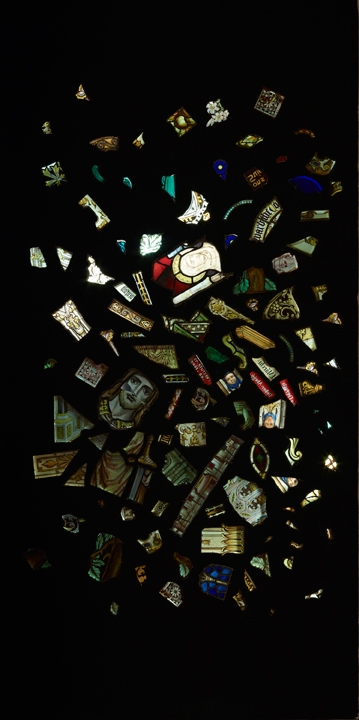The first thing one sees at Lehmann Maupin’s Chelsea location is a drywall inlaid with patterned, multicoloured pieces of glass. It’s a decorative, beautiful work that sets the tone for Kader Attia’s project, which alters the gallery’s architecture and alludes to the fact that nothing is what it seems at first sight. Very soon one discovers the other side of that wall, which reveals that those decorative wedges are the verso of a broken stained-glass window set into the plaster.
Reconfiguring the gallery using temporary walls, Attia’s exhibition unfolds in a maze of small rooms. It opens with an untitled installation that includes a slideshow of album covers of African music that are clearly marketed for a Western audience (one is labelled ‘authentic music’), with the music playing in the background. This theme of cultural export is then picked up in the following room with Dispossession (2013), a series of images of art objects from the Vatican’s ethnographic collection, accompanied by video interviews with intellectuals and others about the status of these objects. Further on there are sculptures mimicking African tribal art; a composition of artificial legs arranged in a circle; a copy of Freud’s Totem and Taboo (1913); a series of collages interposing Greek sculptures, indigenous art and pop culture; and a group of raw canvases cut and sewn together in a gesture that should be reminiscent of Lucio Fontana’s canvases but looks more like a wound stitched by a field doctor.
If this sounds like a lot, that’s because it is. As fitting as the slight claustrophobia of Attia’s labyrinth may be, it also adds to the somewhat muddled nature of the show: it’s hard to build a coherent narrative from all of these disparate pieces, and the exhibition’s title, Show Your Injuries, doesn’t exactly help in tying it all together. The fact that the work is unequal never detracts from the strength of Attia’s interest in the marginalised, and the implications – cultural, socioeconomic – of colonialism. The result goes beyond identity politics and personal injury, and speaks to broader structures of exploitation and to the traumatic circulation of people and culture.
At the gallery’s second New York location, on the Lower East Side, one finds Asesinos! Asesinos! (2014), an installation of over 100 doors, each cut in the middle and then positioned in an A-shape, with megaphones attached on top. Large and inaccessible, the installation looks like a mass of people in a demonstration, silent despite the amplifying devices. In scale and approach, it’s reminiscent of Attia’s impressive Kasbah (2009), where the gallery’s floors are overtaken by the kind of corrugated sheeting used for roofing buildings in poor urban centres – a direct reference to Algerian citadels in this case – complete with discarded tyres and makeshift antennas. Visitors are invited to walk on the sheeting, their inevitable instability bringing to mind the tenuous state of citizens in conflict zones. In Asesinos!…, the silence should function the way the rickety steps do in Kasbah, but instead it leaves one hoping for the sound, the demands, the shouts of a rally. The difference between the works is not in participation: it’s in the strength of the statement. When he is forceful – as in the Chelsea exhibition – Attia is incredibly convincing.
This article was first published in the January & February 2015 issue.
